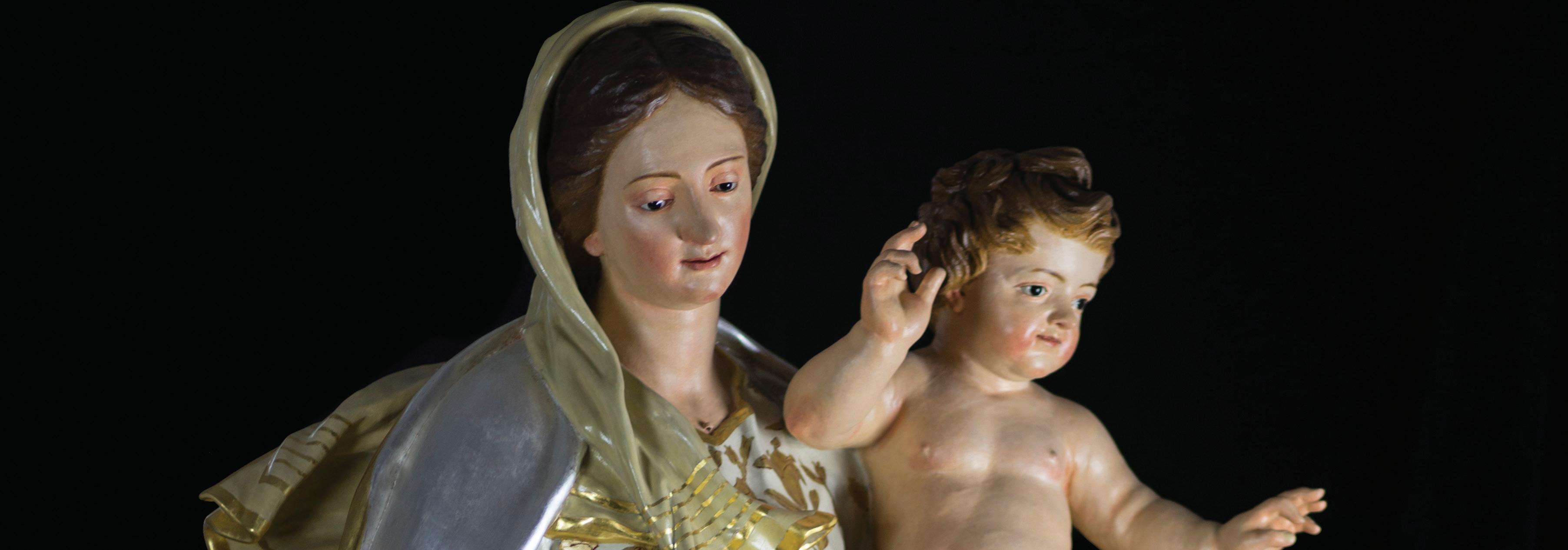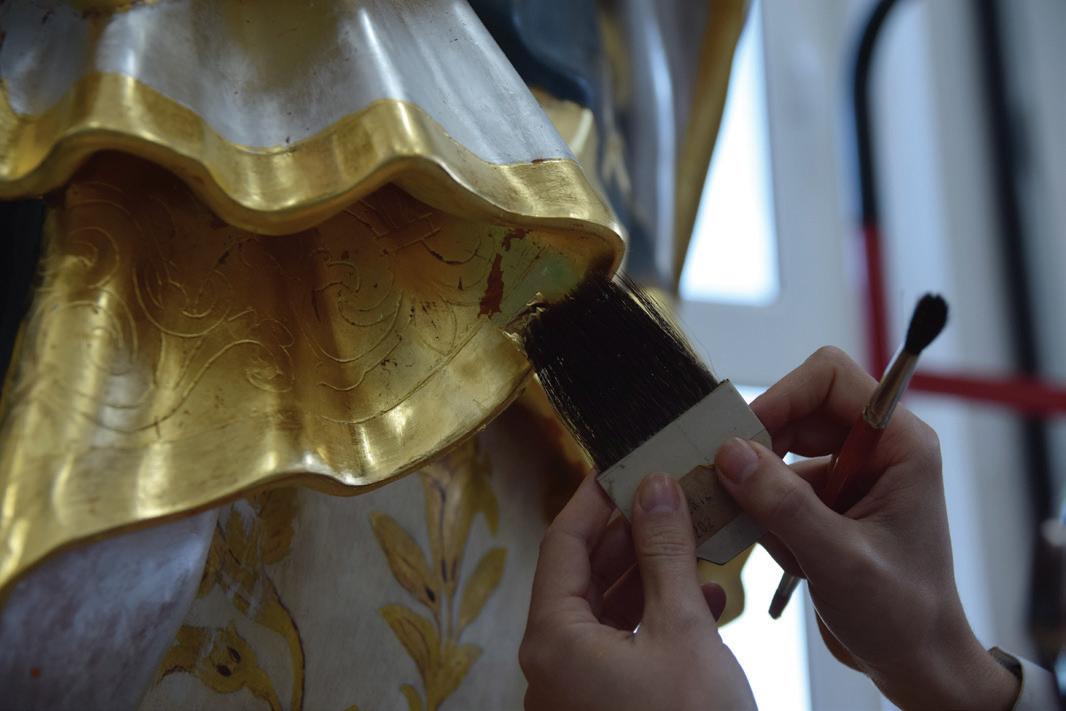
6 minute read
Mount Carmel
The Conservation Project of the Statue of Our Lady of Mount Carmel
Maria Grazia Zenzani & Valentina Lupo Atelier del Restauro ltd
Advertisement
The 18th century statue of Our Lady of Mount Carmel is a life-size wooden polychrome and gilded sculpture (1.82 cm in height). The compromised state of conservation of both the wooden support and paint layer have prompted the Confraternity of Our lady of Mount Carmel in commissioning a professional detailed condition assessment of the state of conservation of the statue in March 2019 to Atelier del Restauro ltd. Several factors most probably including ambient conditions, depletion of original materials, handling and past restoration interventions have lead to a variety of damages presenting themselves over time affecting the current state of conservation of the wooden support and the consecutive preparatory and polychrome layers. Wooden sculptures are particularly sensitive to ambient conditions. Cracks were most probably caused due to a loss of cohesion after that the wood experienced internal physical stresses caused by a combination of factors. Mechanical shock and vibrations from transport and handling in the past might also be the cause of cracks. Inclination transfers the weight of the statue on more fragile areas, generating pressures that can form cracks. The movement of the wood has also formed an overriding network of microscopic cracks in the polychromy, leading to losses and flaking of paint. From the examination carried out it was concluded that the main problem the statue was suffering from was a loss of adhesion between the preparation (gesso) layer (including colour) and the wooden


support. In fact, large areas of polychromy were lost. During the inspection, areas of the statue were ‘knocked’ to check for void areas and it was concluded that areas of the faces and the mantle especially were in need of urgent adhesion and consolidation treatment to avoid the complete detachment of areas of polychromy, which would result in irreversible damage. Over the years the sculpture has undergone multiple restorations, mainly of the polychrome and gilded layers. To date, no records or chronology of past interventions are known; however, it is evident that the statue went through substantial unprofessional interventions in the past. The overpainting was of poor quality and was aesthetically disturbing. During the inspection around three different interventions were observed: • The gilded tunic, which appears not to be the original dating back to the period the statue was made, has been overpainted in several areas using purpurin, which has oxidised with time and altered to a greenish/grey colour. • An intervention at the top of the tunic was carried out whereby a thick overpainted whitish/grey colour was applied over the cream colour. • The gilded decorations at the top part were completely covered with purpurin.
• The inner lining of the mantle was overpainted using a silver grey paint which has oxidised with time. • The polychromy of the skin tones of both the Virgin and Child Jesus was overpainted. • The eyes of the Virgin are made of glass. On inspecting closely, the eyes of Child Jesus it was noted that underneath the paint, glass is visible and they were therefore overpainted using a thick, oil-based paint. The project included a scientific study which was focused in particular on the manufacturing technique and materials of the statue by using diagnostic instruments. These include an X-ray investigation to study the construction of the statue and past interventions to the wooden support. Two samples from the wooden support were extracted in order to identify the species of wood, samples resulted in the statue being made from Pinus sp. (Pine] wood while the base is Picea sp. (Spruce). Next, in order to analyse the multilayered structure and composition of the painted film, micro-samples were taken from different parts of the statue and were analysed through the use of various scientific instruments. This allowed the understating of the exact number of overpainted layers. Then, stratigraphic tests served to provide

indications of the material composition of both the preparatory and pictorial layers of the vest, as well as of the skin tones. As a first step the adhesion of the detachments was carried out. Numerous tests were carried out in order to allow the proper softening of the thick scales of detaching paint in danger of cracking completely. The treatment continued with the use of a conservation-standard microemulsion injected localised through insulin syringes underneath the detaching paint. This allowed the preparation to soften and get the right adhesion without the risk of breakage. The lowering and adhesion of the detachments was carried out through the use of a small heated spatula. Cracks in the wooden support were consolidated through injections of a twocomponent epoxy-resin, specially formulated for grouting and bonding of wooden artefacts subject to movement generated by thermo hygrometric variations. The operations related to the cleaning phase, were complex and laborious. The overpainting substances applied over the robes during the past interventions, constituted of thicknesses and non-homogeneous coatings, including the immense presence of overpaintings provided to a complicated cleaning treatment. The cleaning intervention related to the skin tone the Virgin and Child Jesus was by far a different situation. Stratigraphic analysis of a small sample was carried out under a microscope and revealed that at least three different thick overpaintings were present over the original skin tones This was a meticulous and demanding work which included the softening and removal of the overpaintings using a solvent based gel applied for a set amount of time to soften the layers, then these where removed manually using small scalpel blades under a lens. The removal of the overpaintings revealed a skin tone of refined quality, the cleaning intervention brought out the delicacy of the face with its three dimensional tones, even though several abrasions were found probably attributed to a drastic cleaning intervention carried out in the past. The aesthetical appearance of the skin tone is back , as far as possible to its former splendor and indeed have resurfaced the details; that had been “buried” under the thick overpaintings. The treatments continued with the infilling of the large amount of capillary cracks and lacunae. A flexible infill mixed with a specific percentage of a heat-seal adhesive was devised by the team after several tests, in order to permit elasticity of the infills when movements of the wooden support occur. The infills were then levelled using to the pictorial surface using fixed blades moistened in a hydrocarbon-based solvent. Losses of the gilded layer were integrated using the water gilding technique through the use of Armenian bole and a 23 ¾ carat gold leaf. The new gilded areas were balanced with the original gold by means of light glazes of varnish colours to age and integrate our intervention with the original gilding. Pictorial reintegration was carried out only on abrasions and lacunae to bring back the chromatic integrity of the polychromy by means of tempera and varnish colours through the use of the mimetic technique. In certain areas were the motifs were lost, integration was carried out through reconstruction. In conclusion the statue was varnished, using a synthetic resin with a high resistance to aging and warm temperatures including UV protection. A satin surface finish was given to protect the gilded and painted film and to saturate the colours. The project was carried out following a conservative approach adopted for the long-term preservation of this important statue that necessitates the improvement of both its structure and aesthetics, while at the same time guaranteeing that the statue can continue to safely fulfil its symbolic purpose for future generations to come. All the materials used in the conservation and restoration of the statue have the common characteristic of reversibility and every phase of the project has been documented through photography.












